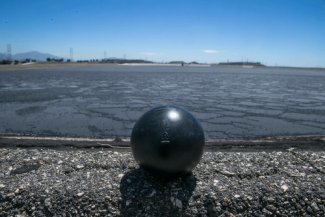Will the Shade Balls Protect Our Drinking Water?

As you may know or not, the Los Angeles Department of Water and Power (LADWP) deployed around 400,000 balls in the Ivanhoe reservoir since 2008 for the environmental reasons. Later in 2015, 96 million shade balls were dumped into the Los Angeles Reservoir to improve water quality and save water. (See picture above- Image credit: AP/Damian Dovarganes).
Shade balls are small plastic spheres made of high-density polyethylene (HDPE) with carbon black additive floated on top of a reservoir for environmental reasons. They are about 4 inches (10 cm) in diameter, and are partially filled with water to avoid being blown by wind. The main objectives of dumping the shade balls into reservoir is preventing the formation of a carcinogenic chemical, bromate, which forms when naturally occurring bromine reacts with chlorine in the presence of sunlight. Other environmental benefits include slow evaporation, prevent algae growth and prevent birds from landing on bodies of water.
According to the Los Angeles Department of Water and Power (LADWP), shade balls could keep contaminants out of the water and reduce the evaporation of the reservoir by 85 to 90 percent during a drought.
However, there is a debate saying that even though the balls saved 1.7 million cubic metres of water from evaporating during their deployment from August 2015 to March 2017, they required 2.9 million cubic metres of water in their manufacture. In other words, the amount of water needed to produce the shade balls appears to be greater than the amount of water saved by preventing evaporation.
On the economic side, the LA Weekly report criticized that the savings of shade balls do not match the cost.(Maddaus 2015)1 More specifically, it takes $34.5 million to manufacture the shade balls, but save only $2 million per year. What’s more, the shade balls need to be replaced every ten years. That’s $20 million of water savings for every $34.5 million of balls. Therefore, it is of great importance to understand the whole life cycle of the shade balls before dumping them into the open reservoir to save our water. Instead, learning from the mistake, quick technological solutions to water management, such as shade balls, need integrated sustainability analyses to reduce the environmental and economic risks.

